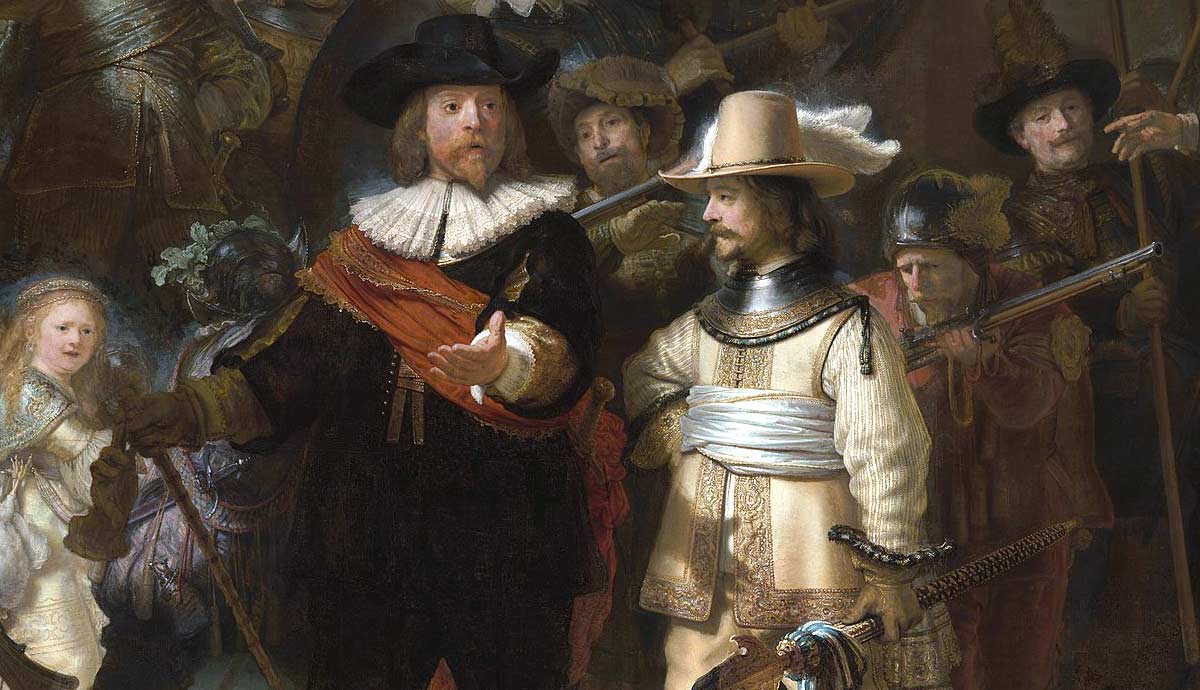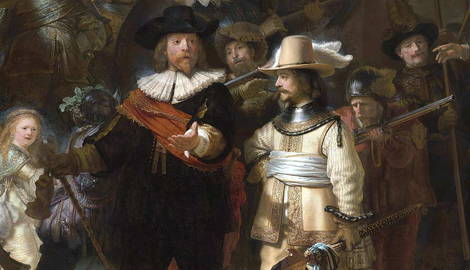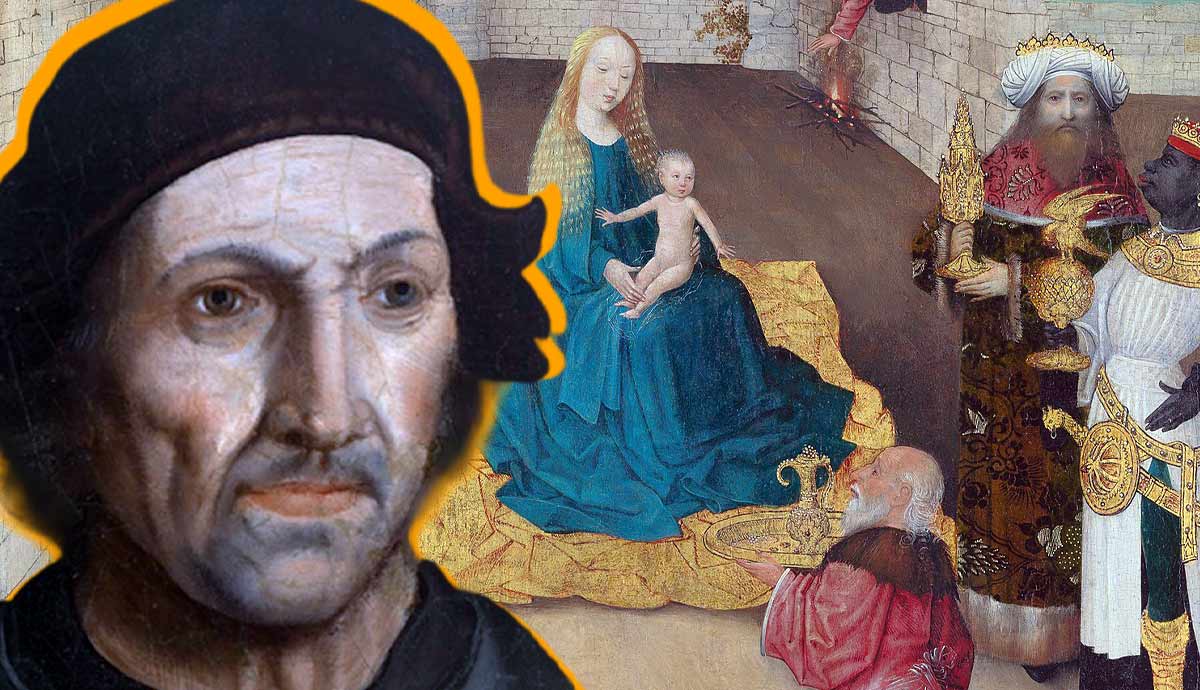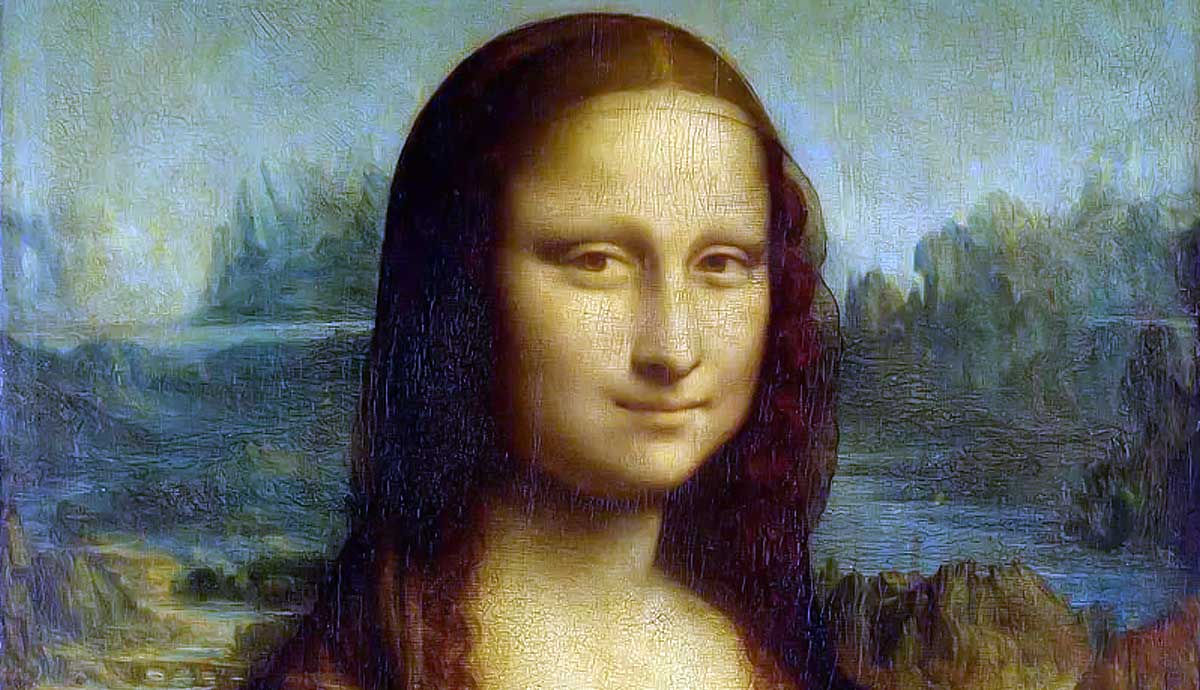
The Night Watch by Rembrandt van Rijn is one of the most analyzed paintings in the history of art. This fascinating artwork has survived many wars, three attacks by vandals, and years of extensive research and attempts to decode its meaning and complex composition. Let’s explore the historical context, hidden details, and controversies surrounding Rembrandt’s famous composition, The Night Watch.
The Origins of Rembrandt’s The Night Watch

Arguably the most famous painting by the Leiden-born painter Rembrandt van Rijn, The Night Watch has been one of the highlights of global art history for centuries. The enormous painting has been reconstructed on film, in theater, and in sculpture on numerous occasions. It has also been the subject of many rumors and speculations.
Around the late 1630s, Rembrandt was a successful and well-known painter based in Amsterdam. He was happily married and resided in a lavish home filled with antique artworks and curiosities. Primarily, he was known as the master of group portraits, especially after his groundbreaking work The Anatomy Lesson of Dr. Nicolaes Tulp was presented in 1632. Instead of simply painting his commissioners in a static, organized row, Rembrandt decided to engage them in a shared activity and add dynamism to the scene.

At some point at the end of the decade, Rembrandt was approached by a unit of civic militia, led by Captain Frans Banninck Cocq. At the time, seven different units commissioned group portraits of their members from different artists to decorate the newly built town hall, where they held their meetings. Rembrandt painted 34 figures in total, funded by 18 commissioners whose names he listed on a shield in the right half of the painting. For his work, Rembrandt was paid 1,600 guilders, with an average yearly income of a worker being 300 guilders.
Rembrandt’s Irony

The composition is unusually complex and filled with events. One of the men is seen loading a gun, while another is shown shooting at an unseen target. One of the strangest and most unexpected figures is a girl carrying a dead rooster and a drinking horn. Her small figure is specifically highlighted among the rest, hinting at her importance. Most likely, she was a personification of the guard’s duty, carrying their symbols on her. Another symbolic hit is the shadow of the captain’s Cocq’s hand that falls onto Lieutenant Willem van Ruytenburch’s mantle, highlighting the Amsterdam coat of arms the lieutenant is wearing.
However, there is another interpretation of the painting apart from Rembrandt glorifying the civic guard. Some researchers suggest that the portrait was bitterly ironic, highlighting the chaos, depravity, and vanity. The drinking horns, the unnecessarily fired shot, the strange girl with a rooster and a weird ageless face—all of them possibly suggest that Rembrandt was not as straightforward and even attempted to mock his commissioners.

Not enough is known about the circumstances of the work’s commission. We know for sure that one of Rembrandt’s models died in December 1640, when he was already working on the painting, and that he finished it in 1642. Some researchers also believe that Rembrandt’s commissioners were not happy with the result. Allegedly, they disliked the composition because the figures were overlapping each other, and Rembrandt’s style was too schematic for their liking. Others, however, insist that the unit members and their captain appreciated the innovative style.
Rembrandt’s Materials and Techniques

Rembrandt’s painting style was indeed extremely unusual and even controversial for his time. Some art historians see Rembrandt as the first radical avant-garde artist who chose to work with human individuality instead of the expected visual attributes. Many of his famous works, including The Night Watch, had a sketch-like look in terms of line and detailing, as he preferred to focus on the impressions of light and shadow. Nonetheless, the figures in his paintings were recognizable and identifiable to those who knew the models personally.
For his painting, Rembrandt used pigments like carmine, produced by crushing cochineal insects, lead white, lead-tin yellow, which gave a lemony hue, and smalt—a blue pigment made from crushed cobalt glass. Moreover, he used arsenic to add more depth to orange and gold tones.

While analysing the tiny paint samples taken from the work, researchers discovered that Rembrandt covered his canvas with a lead-based mixture. This was a groundbreaking discovery, as previously no other works by Rembrandt or his contemporaries were known to contain such a component. Most likely, Rembrandt used warm linseed oil and powdered lead oxide for the mixture. Its main function was to protect the canvas from mold and moisture, as he knew that the painting was intended for a wet town hall wall.
Sketches Under the Surface

During the years-long research project centered around Rembrandt’s most famous work, art historians discovered preparatory sketches for the painting. Rembrandt painted them over the dark background with beige paint, which was unusual for his works yet completely logical. Rembrandt mixed the pigment with chalk to make the paint even more fit to its purpose. The sketches were made visible thanks to a specific technology that tracked the presence of calcium, the primary material in chalk, under the paint layers.
The analysis of sketches has shown that Rembrandt rearranged his figures and their attributes several times. Most frequently, he moved around spears and adjusted leg positions, as well as added and removed decorative elements, such as feathers on the characters’ hats.
Research has shown that the painting, which weighs more than 660 pounds and is over 13 feet long, was even larger in its original state. To fit into the doors of the Amsterdam Town Hall, where it was placed originally, someone cut off four pieces from each side of the canvas. Unfortunately, the pieces have never been found.
“The Night Watch” Conspiracy Theory

The Night Watch and the film inspired by it gave rise to a widespread, nonsensical, but exciting conspiracy theory. In 2007, director Peter Greenaway presented a fiction film titled Nightwatching and a documentary titled Rembrandt’s J’Accuse, both of which were dedicated to a theory regarding the painting’s origins. Greenaway proposed that Rembrandt accidentally revealed a murder plot and left hints to it in the painting.
According to the film, while Rembrandt was working on The Night Watch, one of the militia guards, Piers Hasselburg, was shot in what was perceived to be an accident. While painting, Rembrandt uncovered not only the murder but a series of horrific crimes committed by the unit, and left visual clues and symbols in the painting that hinted at the truth. Greenaway also blamed the guard unit for destroying Rembrandt’s career in retaliation, which resulted in his death in poverty.
Greanaway’s theory is not about the conspiracy itself (his elaborate storytelling has little in common with reality), but an exercise in visual literacy that explores the art of recognizing and understanding small non-verbal clues.
“The Night Watch” by Rembrandt Versus Vandals

Due to its cult status, The Night Watch has become the target for art vandals at least twice during its long life. In 1911, an unemployed former shoemaker and Navy chef came to the Rijksmuseum with a shoemaking knife. Upset by his inability to find a job, he attacked the painting. However, due to the thick layer of varnish that protected the paint layer, the knife only scratched the top, leaving no serious damage. However, the attack prompted art conservators to remove and reapply the varnish, leading to an astonishing discovery. The thick coating had accumulated dust and dirt over the years, becoming brownish-yellow and darkening the entire image. Contrary to the widespread version, The Night Watch was not a nighttime scene, but a picture unfolding on a bright, sunny day.
The second attack occurred in 1975, when Wilhelmus de Rijk, an unemployed school teacher suffering from mental illness, slashed the painting with a bread knife, this time leaving more than a dozen slashes. De Rijk claimed he “did it for the Lord” and committed suicide in a psychiatric hospital before his trial. In 1990, a man who also had a history of mental illness sprayed the painting with concentrated acid from a concealed bottle. Luckily, the guards quickly poured water over the affected area, minimizing the damage.










